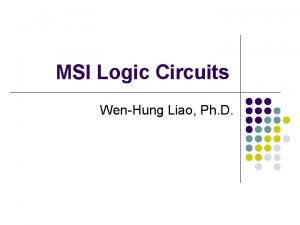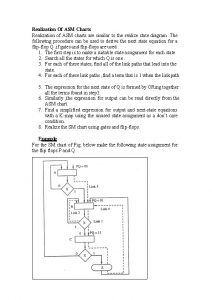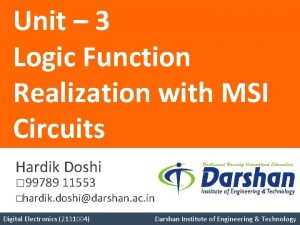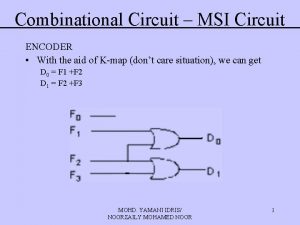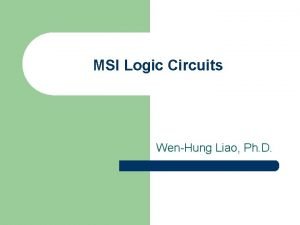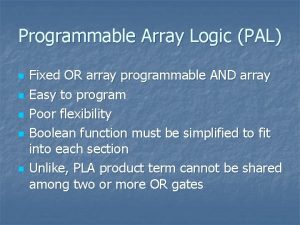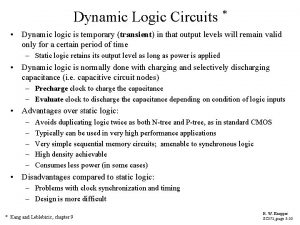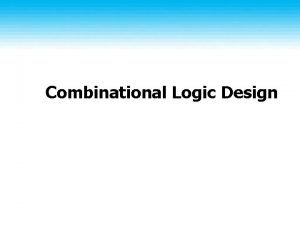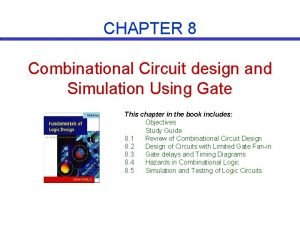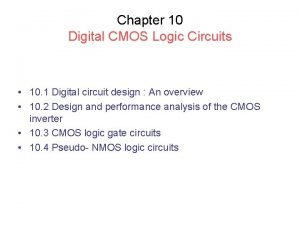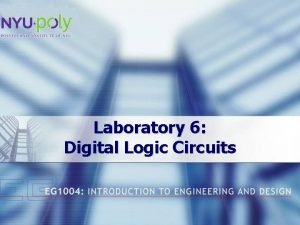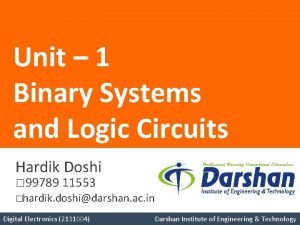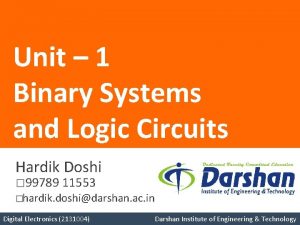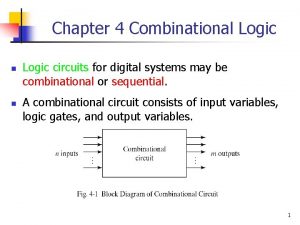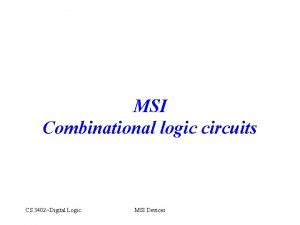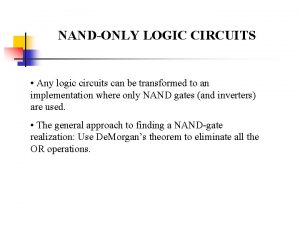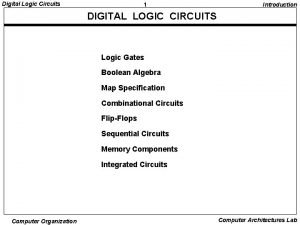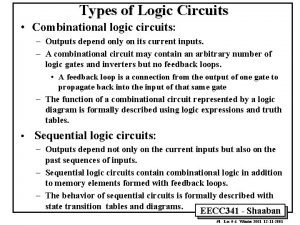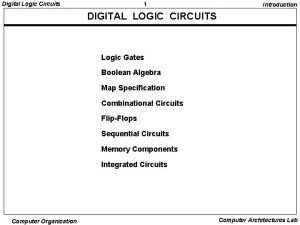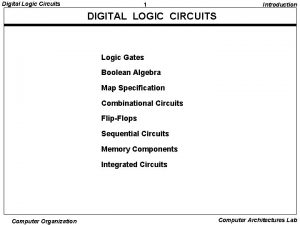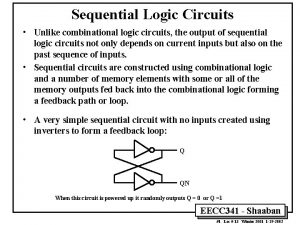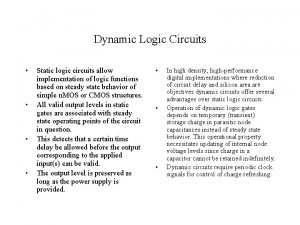Unit 3 Logic Function Realization with MSI Circuits

















- Slides: 17

Unit – 3 Logic Function Realization with MSI Circuits Hardik Doshi � 99789 11553 �hardik. doshi@darshan. ac. in Digital Electronics (2131004) Darshan Institute of Engineering & Technology

Half Adder § A combinational circuit which adds two one-bit binary numbers is called a half-adder. Inputs A B 0 0 0 1 1 1 0 1 A B Outputs Sum Carry 0 0 1 0 S=A⊕B C = AB 0 1 § The sum column resembles like an output of the XOR gate. § The carry column resembles like an output of the AND gate. Unit – 3: Combinational Circuits 3 Darshan Institute of Engineering & Technology

Limitation of Half-Adder § In multi-digit addition we have to add two bits along with the carry of previous digit addition. Such addition requires addition of 3 bits. This is not possible in half-adders. Unit – 3: Combinational Circuits 4 Darshan Institute of Engineering & Technology

Full Adder § In a full adder, three bits can be added at a time. The third bit is a carry from a less significant column. Inputs Outputs A B Cin S Cout 0 0 0 0 1 1 0 0 1 0 1 1 1 0 0 1 1 1 Unit – 3: Combinational Circuits S = A’B’Cin + A’BCin‘ + AB’Cin’ + ABCin = (AB’ + A’B)Cin’ + (AB + A’B’)Cin = (A ⊕ B)Cin’ + (A ⊕ B)’Cin = A ⊕ B ⊕ Cin Cout = A’BCin + AB’Cin + ABCin’ + ABCin = AB + (A ⊕ B)Cin 5 Darshan Institute of Engineering & Technology

Full Adder S = A ⊕ B ⊕ Cin Cout = AB + (A ⊕ B)Cin Logic diagram for full adder A B S = A ⊕ B ⊕ Cin Cout = AB + (A ⊕ B)Cin Half Adder Unit – 3: Combinational Circuits Half Adder 6 Darshan Institute of Engineering & Technology

Half Subtractor § Subtracts one bit from the other and produces the difference. § Other output is to specify if 1 is borrowed A Inputs Outputs B A B d b 0 0 0 1 1 0 0 Unit – 3: Combinational Circuits 7 d=A⊕B b = A’B Darshan Institute of Engineering & Technology

Full Subtractor § Half subtractor can be used only for LSB subtraction. § Borrow from LSBs affects the subtraction in the next higher column. § Subtrahend bit is subtracted from minuend and consider borrow if generated from preceding column. § Full subtractor is a combinational circuit with 3 inputs (A, B, bi) § Subtraction = A – B – bi Unit – 3: Combinational Circuits 8 Darshan Institute of Engineering & Technology

Full Subtractor Inputs Outputs A B bi d b 0 0 0 0 1 1 1 0 1 1 0 0 1 0 1 0 0 1 1 0 0 0 1 1 1 Unit – 3: Combinational Circuits d = A’B’bi + A’Bbi‘ + AB’bi’ + ABbi = (AB’ + A’B)bi’ + (AB + A’B’)bi = (A ⊕ B)bi’ + (A ⊕ B)’bi = A ⊕ B ⊕ bi b = A’B’bi + A’Bbi’ + A’Bbi + ABbi = A’B(bi + bi’) + (AB + A’B’)bi = A’B + (A ⊕ B)’bi 9 Darshan Institute of Engineering & Technology

Full Subtractor d = A ⊕ B ⊕ bi b = A’B + (A ⊕ B)’bi A B d = A ⊕ B ⊕ bi b = A’B + (A ⊕ B)’bi Cin Unit – 3: Combinational Circuits 10 Darshan Institute of Engineering & Technology

Multiplexer § A multiplexer(MUX) is a device that allows digital information from several sources to be routed onto a single line for transmission over that line to a common destination. § Consider an integer ‘m’, which is constrained by the following relation: m = 2 n, where m and n are both integers. § A m-to-1 Multiplexer has • • m Inputs: I 0, I 1, I 2, . . . . I(m-1) One Output: Y n Control inputs: S 0, S 1, S 2, . . . S(n-1) One (or more) Enable input(s) such that Y may be equal to one of the inputs, depending upon the control inputs. Unit – 3: Combinational Circuits 11 Darshan Institute of Engineering & Technology

4 -to-1 Multiplexer 2 n inputs I 0 I 1 I 2 4 x 1 MUX I 0 Y 1 output I 3 Enable (G) S 0 S 1 0 0 Select Inputs S 1 S 0 0 1 1 1 0 1 Output Y I 0 I 1 I 2 I 3 Y = S 1’S 0’I 0 + S 1’S 0 I 1 + S 1 S 0’I 2 + S 1 S 0 I 3 n control inputs Unit – 3: Combinational Circuits 12 Darshan Institute of Engineering & Technology

4 x 1 MUX Actual Circuit I 3 I 2 Y I 1 I 0 S 1 S 0 Enable (G) Unit – 3: Combinational Circuits 13 Darshan Institute of Engineering & Technology

Application of Multiplexer § Logic function generation § Data selection § Data routing § Operation sequencing § Parallel-to-serial conversion § Waveform generation Unit – 3: Combinational Circuits 14 Darshan Institute of Engineering & Technology

Logic function generator § Implement the following function using 8 to 1 MUX F(x, y, z) = Σ m(0, 2, 3, 5) S 2 S 1 S 0 x y z 0 0 0 1 0 1 1 0 0 0 1 1 1 1 0 0 1 1 1 0 F Unit – 3: Combinational Circuits 15 z y x S 0 S 1 S 2 1 0 1 0 0 D 1 D 2 D 3 D 4 D 5 D 6 D 7 8 x 1 MUX Output = F Darshan Institute of Engineering & Technology

Logic function generator § Multiplexer with n-data select inputs can implement any function of n + 1 variables. § The first n variables of the function as the select inputs and to use the least significant input variable and its complement to drive some of the data inputs. § If the single variable is denoted by D, each data output of the multiplexer will be D, D’, 1, or 0. § Suppose, we wish to implement a 4 -variable logic function using a multiplexer with three data select inputs. § Let the input variables be A, B, C, and D; D is the LSB. Unit – 3: Combinational Circuits 16 Darshan Institute of Engineering & Technology

Logic function generator § A truth table for the function F(A, B, C, D) is constructed with ABC has the same value twice once with D = 0 and again with D = 1. § The following rules are used to determine the connections that should be made to the data inputs of the multiplexer. 1. If F = 0 both times when the same combination of ABC occurs, connect logic 0 to the data input selected by that combination. 2. If F = 1 both times when the same combination of ABC occurs, connect logic 1 to the data input selected by that combination. 3. If F is different for the two occurrences of a combination of ABC, and if F = D in each case, connect D to the data input selected by that combination. 4. If F is different for the two occurrences of a combination of ABC, and if F = D in each case, connect D to the data input selected by that combination. Unit – 3: Combinational Circuits 17 Darshan Institute of Engineering & Technology

Implement the following function using 8 to 1 MUX F = Σ m(0, 1, 2, 3, 4, 10, 11, 14, 15) S 2 S 1 S 0 A B C 0 0 0 0 1 1 1 F=1 0 0 1 1 0 F = D’ 0 0 1 1 0 1 0 0 F=0 1 1 0 0 0 1 0 0 F=0 1 1 1 F=1 1 1 0 0 0 1 0 0 F=0 1 1 1 F=1 D F C B A S 0 S 1 S 2 1 1 D’ 0 0 1 D 0 D 1 D 2 D 3 D 4 D 5 D 6 D 7 8 x 1 MUX Output = F
 Binary full subtractor
Binary full subtractor Msi logic circuits
Msi logic circuits Asm chart for jk flip flop
Asm chart for jk flip flop Msi circuits
Msi circuits Msi circuit
Msi circuit Msi digital systems
Msi digital systems Advantages of parallel circuit over series circuit
Advantages of parallel circuit over series circuit Programmable array logic circuit
Programmable array logic circuit Dynamic nand gate
Dynamic nand gate Combinational logic circuits
Combinational logic circuits Combinational circuit design and simulation using gates
Combinational circuit design and simulation using gates Nmos inverter
Nmos inverter Combinational logic circuits lab report
Combinational logic circuits lab report Logic gates worksheet
Logic gates worksheet Binary systems and logic circuits
Binary systems and logic circuits Binary systems and logic circuits
Binary systems and logic circuits For a three variable combinational circuits, m(1,4,7)=
For a three variable combinational circuits, m(1,4,7)= First order logic vs propositional logic
First order logic vs propositional logic

